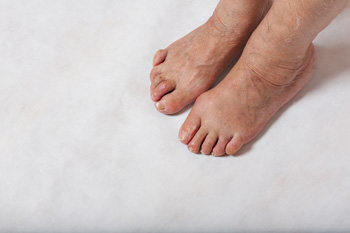Items filtered by date: May 2023
Many Types of Crooked Toes

There are many types of crooked toes, including hammertoe, mallet toe, claw toe, curly toe, and overlapping toe. These abnormalities may be caused by a genetic disposition, tight or ill-fitting shoes, injury or trauma, or obesity. Nerve damage and joint damage are other possible causes. If left untreated, any of these types of crooked toes may cause further complications, the most common of which are pain and irritation when wearing shoes. Other problems that may develop from crooked toes are inflammation, open sores, corns, and calluses. Treatment options depend on the type, severity, and length of the particular condition. The first suggestion for treating any type of crooked toe is to change footwear to accommodate it. This may include buying shoes that fit correctly or not wearing certain types of shoes, such as high heels. Various exercises, taping, splints, and surgery are other treatment options. If the pain from a crooked toe worsens, it is suggested that you make an appointment with a podiatrist. This foot specialist can examine the toe and make a determination on how best to treat it.
Toe pain can disrupt your daily activities. If you have any concerns, contact Dr. Michael A. Wood of Foot Health Institute. Our doctor can provide the care you need to keep you pain-free and on your feet.
What Causes Toe Pain?
Most severe toe pain is caused due to a sports injury, trauma from dropping something heavy on the toe, or bumping into something rigid. Other problems can develop over time for various reasons.
Toe pain can be caused by one or more ailments. The most common include:
- Trauma
- Sports injury
- Wearing shoes that are too tight
- Arthritis
- Gout
- Corns and calluses
- Hammertoe
- Bunions
- Blisters
- Ingrown toenails
- Sprains
- Fractures (broken bones)
- Dislocations
When to See a Podiatrist
- Severe pain
- Persistent pain that lasts more than a week
- Signs of infection
- Continued swelling
- Pain that prevents walking
Diagnosis
In many cases the cause of toe pain is obvious, but in others, a podiatrist may want to use more advanced methods to determine the problem. These can range from simple visual inspections and sensation tests to X-rays and MRI scans. Prior medical history, family medical history, and any recent physical traumatic events will all be taken into consideration for a proper diagnosis.
Treatment
Treatments for toe pain and injuries vary and may include shoe inserts, padding, taping, medicines, injections, and in some cases, surgery. If you believe that you have broken a toe, please see a podiatrist as soon as possible.
If you have any questions please feel free to contact one of our offices located in Lansing, and Chicago, IL . We offer the newest diagnostic tools and technology to treat your foot and ankle needs.
What Is Foot Drop?

Foot drop occurs when the peripheral nerves controlling the feet become compressed or damaged. This can happen from a neurological problem, such as multiple sclerosis or a stroke, or a nerve issue. Those with diabetes, a herniated disk, or calcium deposits in the spine are more apt to develop foot drop. Sitting cross-legged or kneeling for prolonged periods, as well as injury or surgery involving the knee, hip, or lower back, can contribute to this condition as well. Foot drop can cause weakness and paralysis in muscles that pull the foot toward the shin, in addition to walking difficulties. This affliction can come on gradually or suddenly. Precursors include one shoe feeling looser than the other and the foot being difficult to lift, walking with a higher step, or one foot feeling weaker or numb compared to the other foot. Ankle and foot braces, exercises, nerve stimulation, and surgery can help with this condition. If you have problems with your feet and suspect foot drop, it is strongly suggested that you visit a podiatrist for a proper diagnosis and to get treatment underway.
Ankle pain can be caused by a number of problems and may be potentially serious. If you have ankle pain, consult with Dr. Michael A. Wood from Foot Health Institute. Our doctor will assess your condition and provide you with quality foot and ankle treatment.
Ankle pain is any condition that causes pain in the ankle. Due to the fact that the ankle consists of tendons, muscles, bones, and ligaments, ankle pain can come from a number of different conditions.
Causes
The most common causes of ankle pain include:
- Types of arthritis (rheumatoid, osteoarthritis, and gout)
- Ankle sprains
- Broken ankles
- Achilles tendonitis
- Achilles tendon rupture
- Stress fractures
- Bursitis
- Tarsal tunnel syndrome
- Plantar fasciitis
Symptoms
Symptoms of ankle injury vary based upon the condition. Pain may include general pain and discomfort, swelling, aching, redness, bruising, burning or stabbing sensations, and/or loss of sensation.
Diagnosis
Due to the wide variety of potential causes of ankle pain, podiatrists will utilize a number of different methods to properly diagnose ankle pain. This can include asking for personal and family medical histories and of any recent injuries. Further diagnosis may include sensation tests, a physical examination, and potentially x-rays or other imaging tests.
Treatment
Just as the range of causes varies widely, so do treatments. Some more common treatments are rest, ice packs, keeping pressure off the foot, orthotics and braces, medication for inflammation and pain, and surgery.
If you have any questions, please feel free to contact one of our offices located in Lansing, and Chicago, IL . We offer the newest diagnostic and treatment technologies for all your foot care needs.
Plantar Fasciitis in Teachers

Different types of people can be more susceptible than others to developing a foot condition that is known as plantar fasciitis, due to the nature of their employment or lifestyle. For example, teachers might be one such group. There are many reasons for this. Specifically, teachers, especially elementary school teachers, spend a significant amount of the day on their feet. Teachers often walk around the classroom to check on students and spend a great deal of time standing at the board to instruct. As a result of all of this strain on the feet, the teacher may aggravate the plantar fascia, the band of tissue that runs from the toes to the heel in the sole of the foot, and plantar fasciitis can develop. This condition brings with it pain and inflammation, especially felt in the heel. If you are a teacher and are experiencing such pain, it is suggested that you contact a podiatrist today for immediate attention.
Plantar fasciitis can be very painful and inconvenient. If you are experiencing heel pain or symptoms of plantar fasciitis, contact Dr. Michael A. Wood from Foot Health Institute. Our doctor can provide the care you need to keep you pain-free and on your feet.
What Is Plantar Fasciitis?
Plantar fasciitis is the inflammation of the thick band of tissue that runs along the bottom of your foot, known as the plantar fascia, and causes mild to severe heel pain.
What Causes Plantar Fasciitis?
- Excessive running
- Non-supportive shoes
- Overpronation
- Repeated stretching and tearing of the plantar fascia
How Can It Be Treated?
- Conservative measures – anti-inflammatories, ice packs, stretching exercises, physical therapy, orthotic devices
- Shockwave therapy – sound waves are sent to the affected area to facilitate healing and are usually used for chronic cases of plantar fasciitis
- Surgery – usually only used as a last resort when all else fails. The plantar fascia can be surgically detached from the heel
While very treatable, plantar fasciitis is definitely not something that should be ignored. Especially in severe cases, speaking to your doctor right away is highly recommended to avoid complications and severe heel pain. Your podiatrist can work with you to provide the appropriate treatment options tailored to your condition.
If you have any questions please feel free to contact one of our offices located in Lansing, and Chicago, IL . We offer the newest diagnostic and treatment technologies for all your foot and ankle needs.
Flip-Flops and Heel Pain

Flip-flops are often worn at the beach or around pools, but they are also worn as regular summertime footwear. These sandals are often thin-soled and offer little arch and foot cushioning support. Wearing these types of shoes long-term can lead to painful plantar fasciitis, which is a condition that affects the plantar fascia. This is the band of tissue that runs from the heel to the toes on the bottom of the foot, and may endure small tears or become overstretched. Plantar fasciitis can cause severe foot pain, particularly with the first steps after arising from sleep, or from walking for a prolonged period. If plantar fasciitis is not treated, a heel spur can develop, further irritating the foot. Flip-flops should be left for protecting feet in locker rooms or around the water, and more supportive shoes should be worn for other activities. If you have developed plantar fasciitis from wearing flip-flops, it is suggested that you consult with a podiatrist who can help you with treatment options, and recommend better summertime footwear.
Flip-flops can cause a lot of problems for your feet. If you have any concerns about your feet or ankles, contact Dr. Michael A. Wood from Foot Health Institute. Our doctor will assist you with all of your foot and ankle needs.
Flip-Flops and Feet
Flip-flops have managed to become a summer essential for a lot of people. While the shoes may be stylish and easy to slip on and off, they can be dangerous to those who wear them too often. These shoes might protect you from fungal infections such as athlete’s foot, but they can also give you foot pain and sprained ankles if you trip while wearing them.
When Are They Okay to Wear?
Flip-flops should only be worn for very short periods of time. They can help protect your feet in places that are crawling with fungi, such as gym locker rooms. Athlete’s foot and plantar warts are two common fungi that flip-flops may help protect your feet against.
Why Are They Bad for My Feet?
These shoes do not offer any arch support, so they are not ideal for everyday use. They also do not provide shock absorption or heel cushioning which can be problematic for your feet. Additionally, you may suffer from glass cuts, puncture wounds, and stubbed toes since they offer little protection for your feet.
More Reasons Why They Are Bad for Your Feet
- They Slow You Down
- May Cause Blisters and Calluses
- Expose Your Feet to Bacteria
If you have any questions, please feel free to contact one of our offices located in Lansing, and Chicago, IL . We offer the newest diagnostic and treatment technologies for all your foot care needs.
Plantar Warts Can Be Treated!
Causes of a Broken Foot

A sudden accident or fall may cause the foot to fracture. This is also known as a broken foot, and often requires immediate medical attention. Common symptoms many people can experience with this condition include bruising, swelling, and it is often difficult, if not impossible, to walk. If the fracture is severe, a bone may protrude from the skin, and surgery may be necessary to replace and realign the affected bone. A diagnosis is often performed that can determine the severity of the break, and this is done by having an X-ray taken. The correct treatment can consist of wearing a boot that allows mobility, and frequently elevating the affected leg as often as possible. The average recovery time for a broken foot is approximately eight weeks, and normal activities can gradually resume once the healing process is completed. If you have broken your foot, and continue to have pain and swelling, it is suggested that you consult with a podiatrist who can help you to manage this condition.
A broken foot requires immediate medical attention and treatment. If you need your feet checked, contact Dr. Michael A. Wood from Foot Health Institute. Our doctor can provide the care you need to keep you pain-free and on your feet.
Broken Foot Causes, Symptoms, and Treatment
A broken foot is caused by one of the bones in the foot typically breaking when bended, crushed, or stretched beyond its natural capabilities. Usually the location of the fracture indicates how the break occurred, whether it was through an object, fall, or any other type of injury.
Common Symptoms of Broken Feet:
- Bruising
- Pain
- Redness
- Swelling
- Blue in color
- Numbness
- Cold
- Misshapen
- Cuts
- Deformities
Those that suspect they have a broken foot shoot seek urgent medical attention where a medical professional could diagnose the severity.
Treatment for broken bones varies depending on the cause, severity and location. Some will require the use of splints, casts or crutches while others could even involve surgery to repair the broken bones. Personal care includes the use of ice and keeping the foot stabilized and elevated.
If you have any questions please feel free to contact one of our offices located in Lansing, and Chicago, IL . We offer the newest diagnostic and treatment technologies for all your foot and ankle needs.

